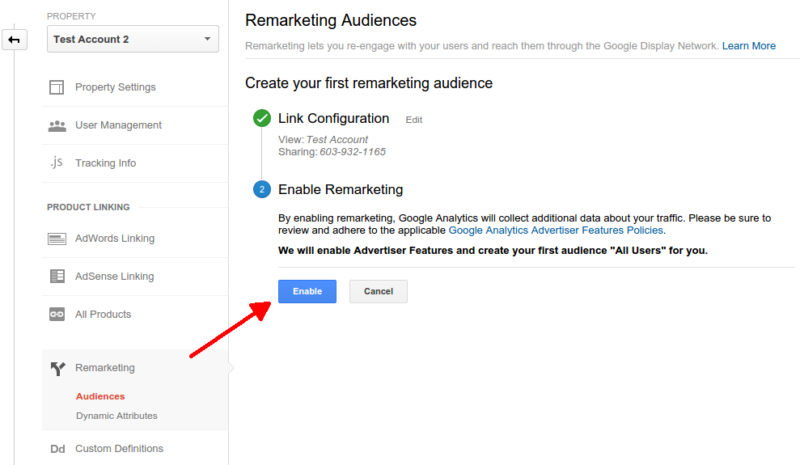Key Features of Remarketing In Google Analytics Explained
Key Features of Remarketing In Google Analytics Explained
Blog Article
Optimize Your ROI With Remarketing in Google Analytics
By taking advantage of the power of user data and customizing advertisements to details target market sections, businesses can dramatically magnify their conversion prices. The journey to optimizing ROI with remarketing is a nuanced course paved with understandings and opportunities that can reshape the trajectory of your advertising and marketing endeavors.
Comprehending Remarketing in Google Analytics
Recognizing remarketing in Google Analytics is necessary for enhancing your electronic advertising and marketing method. Remarketing enables you to target individuals that have actually previously visited your site or engaged with your application, presenting them with customized ads as they surf other websites or utilize various other applications within the Google Present Network. This technique aids maintain your brand top of mind and motivates customers to return to your website, ultimately raising the possibility of conversion.
By using Google Analytics, you can track the efficiency of your remarketing projects, obtaining important understandings into individual actions, involvement, and conversions. This data allows you to fine-tune your targeting, bidding, and messaging strategies to improve the total performance of your campaigns.
Additionally, understanding the different kinds of remarketing checklists readily available in Google Analytics, such as typical, vibrant, and comparable target markets, permits you to create very fractional and individualized campaigns customized to certain individual sections. This level of granularity can considerably boost the importance and impact of your remarketing initiatives, inevitably optimizing your return on investment.
Establishing Remarketing Checklists
To properly execute remarketing projects in Google Analytics, the first step entails setting up and creating remarketing listings targeting particular customer sections based on their communications with your site or app. By establishing remarketing listings, you can tailor your advertising efforts to reach individuals who have actually currently shown passion in your product and services.
To start, navigate to the Admin section of your Google Analytics account and select the Residential or commercial property where you wish to produce the remarketing list. After that, under the Home column, click on 'Target market Definitions' and choose 'Target markets.' Next, click on the red 'New Target market' button and select 'Create New' to define the specifications for your remarketing list.

Crafting Effective Remarketing Advertisements

When crafting your ads, concentrate on producing eye-catching headings and engaging visuals that attract attention to prospective customers. Incorporate solid calls-to-action that urge customers to revisit your site and complete a wanted activity. Use dynamic remarketing to reveal individualized ads featuring services or products that users have actually formerly checked out on your site.
Additionally, make sure that your ads are mobile-friendly since a substantial section of net traffic comes from mobile phones. Test various advertisement variants to identify which messages and designs drive the very best results. By continuously refining and maximizing your remarketing ads based on efficiency information, you can optimize their performance and improve your return on financial investment.
Studying Remarketing Efficiency

With Google Analytics, marketing professionals can track the performance of their remarketing campaigns in real-time, permitting them to identify fads, patterns, and locations for renovation quickly. By evaluating the information, online marketers can identify which advertisements are doing well, which audience sections are reacting positively, and which channels Discover More are driving the most conversions. This degree of granularity allows marketing professionals to make data-driven decisions to optimize their remarketing campaigns for much better results.
Optimizing ROI With Remarketing
Assessing remarketing information in Google Analytics enables marketing experts to determine possibilities for enhancing roi (ROI) via critical modifications - What Is “Remarketing” In Google Analytics?. To make the most of ROI with remarketing, it is vital to comprehend the habits of your audience. By evaluating individual interactions, such as the web pages they saw, the items they saw, or the actions they tackled your website, you can customize your remarketing projects better
Segmenting your target market based upon their habits allows you to create personalized and targeted advertisements that are more probable to resonate with them. By showing pertinent ads to details sections of your audience, you can raise the opportunities of conversion and eventually improve your ROI.
Furthermore, examining different advertisement creatives, messaging, and deals can help recognize what resonates ideal with your audience. A/B screening allows you to trying out different components of your ads to establish what drives the greatest involvement and conversion prices.
Verdict
To conclude, making the most of ROI with remarketing in Google Analytics requires a calculated approach to examining user actions, segmenting audiences, producing customized ads, and enhancing project performance. By leveraging data-driven insights and examining different approaches, organizations can improve their remarketing efforts to drive higher involvement and conversion rates. This methodical strategy guarantees that resources are successfully assigned towards making best use of rois in remarketing projects.
Next, click on the red 'New Audience' switch and pick 'Develop New' to define the criteria for your remarketing list.
By constantly refining and enhancing your remarketing ads based on performance information, you can optimize their effectiveness and enhance your return on financial investment.
By diving right into these understandings, marketers can get a comprehensive understanding of exactly how their remarketing efforts are reverberating with their target audience and driving conversions. To maximize ROI with remarketing, it is essential to comprehend the actions of your audience.In verdict, maximizing ROI with remarketing in Google Analytics needs a critical technique to assessing customer actions, segmenting target markets, developing customized advertisements, and maximizing campaign performance.
Report this page